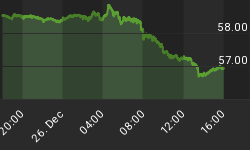Iran’s current economic crisis is worse than anything in past few decades: Inflation is running at over 10 percent and the price of imported items, such as medicine, is beyond the pocketbook potential of most.
And if we look at the implied annual inflation rate, it’s over 200 percent according to Forbes—20 times the official inflation rate of 10.2 percent.

(Click to enlarge)
At the same time, Iran’s oil exports have dropped 8 percent in the past two months, and youth unemployment stands at around 30 percent.
Many Iranian can no longer afford food or rent.
As a result of political and economic insulation, millions people are out of jobs and on the street. It’s so bad that, according to Radio Free Europe/Radio Liberty, even Afghan migrants are fleeing the country to go back home. The demand for work in Iran’s gray economy has declined sharply. Related: Credit Card Giant Caught Swindling Customers
The Iranian rial is in a dangerous spiral.

(Click to enlarge)
In less than a year, the rial has lost half its value. The unofficial value of the rial has roughly halved since the start of the year, to 95,000 to the dollar. Iranian media claim the rate of exchange for the US dollar reached 120,000 rials on Monday, July 30.
Iranians are desperately trying to make ends meet and find a way out of the darkness.
Widespread public dissatisfaction with incumbent politicians is snowballing, and they’re calling for the heads of the most corrupt.
According to Iran’s Mehr News Agency, 90 members of Parliament recently signed a petition to impeach the Minister of Economy.
Related: American Money Is Moving Abroad
Local media also report that five officials from the Ministry of Industry were arrested on charges of corruption and abuse of funds for the importing of thousands of luxury cars.
U.S. Secretary of State Mike Pompeo has accused Iran's leaders of fleecing their country's economy. In a speech at the Reagan National Library, Pompeo specifically called out Supreme Leader Ali Khamenei for allegedly profiting off a $95-billion hedge fund.
"The level of corruption and wealth among regime leaders shows that Iran is run by something that resembles the mafia more than a government,” Pompeo said.
Others have blamed the moderate Rouhani administration for the economic meltdown. On August 1, 80 members of Parliament tabled a motion to question Rouhani about his administration’s economic policy and what it plans to do, according to RadioFarda.
One of the underlying reason for the Iranian market instability is the tension with Washington, even though sanctions haven’t played a direct role in the economic meltdown—yet.
On August 6, a phase of new U.S. sanctions will go into effect, targeting Iranian purchases of U.S. dollars, while sanctions on Iranian oi and foreign financial institutions dealing with Iran’s central bank will go into effect on November 4.
Many Iranians are prepared for this second round of U.S. sanctions to be much worse than the last because this time around, the Iranian economy is starting from a weaker position.
But this all may backfire. Withdrawing from the nuclear deal and slapping sanctions for the moderate Rouhani government to deal with may land Iran’s hardliners back in power and the next regime change in Iran could be much more dangerous.
By Damir Kaletovic for Safehaven.com
More Top Reads From Safehaven.com

















